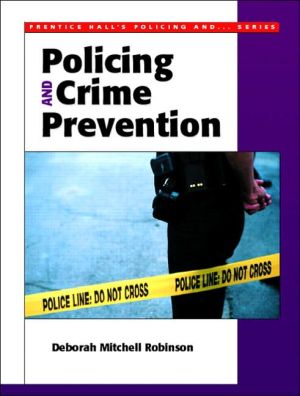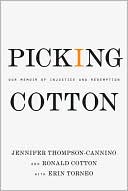Policing and Crime Prevention
With the increase in policing technology, crime prevention has become a major part of local, state, and federal policing. Research into the area of crime prevention has also allowed for developing, implementing, and testing various crime prevention programs for effectiveness in reducing crime.\ In Policing and Crime Prevention Dr. Deborah Mitchell Robinson, and co-authors, stress throughout the text that the idea of police and community interaction is to build a successful crime prevention...
Search in google:
This examination of the police and their role in crime prevention provides readers with a unique view of how each interacts with the other, and an exploration of current and diverse issues.The book covers the criminal justice field, crime prevention at schools (from kindergarten through college campuses), specific crime prevention programs implemented by police, and a synopsis and evaluation of all the material it contains.For police personnel, community citizens, and use in crime prevention courses.
The concept of crime prevention is as old as policing. In modem society, crime prevention is a major issue, especially important to police agencies and their officers, the very individuals to whom the American public turns for protection. Crime prevention is a multifaceted concept, ranging from an individual's responsibility for locking doors to society's responsibility for the suppression/prevention of terrorism. It takes on many forms, from the identification and modification of physical structures and environments to the modification of individual attitudes toward personal safety. Crime prevention is an ever-changing concept, mirroring the continuous and inevitable changes in society. From these changes a myriad of crime prevention definitions, techniques, strategies, and programs have emerged, more or less effective in varying degrees. It is generally accepted that there will always be laws, crime, and a need for policing and crime prevention.\ Many crime prevention ideologies today share a common bond to the model of Crime Prevention Through Environmental Design (OPTED), created in 1971 by C. Ray Jeffery. The basic premise of this model is that "through environmental design, areas may be made safer and the quality of life may be enhanced for individuals living in or using those areas" (Robinson 1998a, p. 32). This idea has implications for all communities throughout the country. "By focusing attention on the physical environment, the OPTED model concerns itself with offense areas," those areas where crimes are committed (Robinson 1998b, p. 45). Under this model, all citizens in a community can participate in crime prevention techniques by adjusting the environment to reduce crime.\ Many crime prevention programs have been created by police agencies. These programs, or strategies, have been developed as policing policies, many under the heading of "community-oriented policing." Community-oriented policing strategies may take on any of several focuses within the community: specific areas and groups may be targeted, or general strategies may be adopted to prevent crime throughout the entire community. By focusing on the environmental aspects of the community, "the frequency of certain types of criminal behavior may be reduced through identification and modification of the environmental conditions under which such offenses occur" (Robinson 1998a, p. 32). Many police agencies employ a combination of community-oriented policing programs, using specifically targeted strategies within a broader, general strategy.\ The purpose of this text is to give the reader an introduction to policing and crime prevention, as well as the interaction between them. With the increase in policing technology, crime prevention has become a major part of local, state, and federal policing. Research into the area of crime prevention has also allowed for developing, implementing, and testing various crime prevention programs for effectiveness. Crime prevention is becoming a major part of many academic curricula in criminology and criminal justice and has become important in police academy training. Many police departments are creating specific crime prevention units with the purpose of establishing relations within the community. Both policing professionals and the general public understand that crime prevention is not only a desired aspect of policing but also a necessity. A successful crime prevention strategy involves both police officers and ordinary citizens.\ Throughout this text, the need for police-community interaction to build a successful crime prevention program is emphasized. It is important that everyone understands the need for each individual to accept a stake in preventing crime, as well as participation in that prevention.\ This text is divided into four sections, containing a total of ten chapters. Section I is titled "Historical Aspects of Policing and Crime Prevention." In Chapter 1, author C. Frank Simons discusses the U.S. Department of Justice's "Operation Weed and Seed" crime prevention program and its current level of success. Simons traces the recent developments in crime prevention to the early 1900s, when police officers began to understand that effectiveness may be best measured by the absence of crime rather than by the number of arrests. Operation Weed and Seed is best described in the words of the Attorney General of the United States, Janet Reno, in her testimony before the Senate Appropriations Committee on April 22, 1993:\ The Weed and Seed Program is one of those good ideas that began as an interagency pilot program in a few cities and is now firmly established. Weed and Seed has the comprehensive objective of weeding out crime from designated neighborhoods, moving in with a wide range of crime and drug programs, and then seeding these neighborhoods with a comprehensive range of human service programs that stimulate revitalization.\ \ In Chapter 2 titled "Cooperation and Coordination in Improving Crime Prevention Strategies," authors John R. Pike and Laura S. Gaultney provide an analysis of crime prevention strategies that may be employed by policing agencies. These strategies include turf protection, pride, intelligence disseiftination, professional courtesy and ethics, public relations and trust, Reverse 911, combined resources, crossing jurisdictional lines, and resource indexing. The authors examine these issues and how each relates to the prevention of crime. Many of these issues are common sense, but common sense seems to take a backseat when governmental agencies are concerned, even when the goal is cooperation and coordination.\ In Chapter 3, titled "Public versus Private Security: Whom Do We Trust?", author Pamela Ann Sexton-Alyea identifies the issues relating to the decision to choose between public and private security agencies. Sexton-Alyea discusses the media and how it has presented both types to the public. The techniques public and private security agencies use to address crime prevention are also discussed. Issues in choosing a specific policing agency include (1) armed versus unarmed guards, (2) salaries of private and public officers, (3) age of the officers, (4) level of education of the officers, (5) number of employees, and (6) union versus nonunion officers.\ Section II of the text is titled "Policing and Crime Prevention in the Academic Setting." This section includes crime prevention techniques and strategies in elementary, secondary, and higher education. In Chapter 4, "Crime Prevention Through Environmental Design (CPTED) in Elementary and Secondary Schools," author Matthew Robinson examines the role of crime prevention in the American K-12 school system. In the wake of recent violent attacks and mass murders in schools, crime prevention has become an important issue for both teachers and education administrators. Robinson discusses how CPTED—which involves numerous alterations to the physical, psychological, and social environments of buildings, individuals, and groups—is being used in U.S. elementary and secondary schools. As the goals of CPTED are to reduce criminal victimization as well as lower perceptions of risk and fear of crime, Robinson documents the degree to which such crime prevention strategies achieve their intended objectives.\ In Chapter 5, "The Bibb County Model for Community Policing in Schools," author Michael S. Dom outlines the proven policing approach that has been used by the Bibb County, Georgia, Board of Education Campus Police Department to reduce crime on all the county's school campuses. Dorn discusses the success of this department and the techniques used to thwart six planned school shootings, one planned school bombing, and one planned double suicide. The Bibb County Model was developed with significant involvement by students, parents, teachers, the clergy, the media, and the general public; it is widely used as a national model for community-based crime prevention through school-police partnerships. As a direct result of the success of this program, Dorn is involved in training more than five-thousand educators and public safety officials yearly and has produced two international safety videos.\ In Chapter 6, "Creating That Invisible Shield," authors James W. Rowe and Deborah Mitchell Robinson discuss designing, planning, and instituting an "invisible shield" to protect university and college campus communities. Rowe and Robinson analyze how traditional and nontraditional crime prevention techniques are employed by campus police officers and departments in protecting their institutions and satisfying the requirement that they meet or exceed the standards of protection expected by their students, their administrators, and the courts. Rowe and Robinson present a list of options from which the reader may select and possibly adapt a combination of programs and approaches that will best meet his or her needs and satisfy the campus community policing approach within his or her geographic location, be it rural or urban, public or private.\ Section III of the text is titled "Policing and Crime Prevention Programs at Work." In Chapter 7, "Crime Prevention in Public Housing," author Brian McDonough examines the increased attention given to crime in public housing by the media, governmental agencies, and criminal justice researchers. McDonough focuses on Curries Woods in Jersey City, New Jersey, a public housing development that has seen its share of rising crime and social disorder activity. With the use of governmental funding to combat the rampant drug and violent crime problems within public housing, the Jersey City Housing Authority and Jersey City Police Department have worked closely together to develop proactive strategies to reduce and eliminate drug trafficking and violent crime. McDonough discusses the myriad of crime prevention strategies implemented that aided the transformation of a crime-infested high-rise project into a more secure, gated townhouse community. These strategies included the following: community redesign using CPTED techniques; development of resident entry monitoring stations staffed by trained resident monitors; community-police problem-solving meetings; resident-management police conferences; a resident-oriented Citizen Police Academy; a continuous deployment of Jersey City Police Community Service Officers; hiring of an off-duty site-based officer using PHDEP (Public Housing Drug Elimination Program) funding; and consistent enforcement of the "One Strike and You're Out" Public Housing Policy.\ In Chapter 8, "Shadows of the Street: Policing, Crime Prevention, and Gangs," author Gordon A. Crews examines the role of crime prevention with regard to juvenile gangs. Crews discusses the characteristics of gangs, their impact in schools, and how crime prevention programs targeted toward gang activities must be realistic because, unfortunately, many communities still deny the presence of juvenile gangs. Crews advocates a community-oriented policing approach to preventing gang violence, in which the community and the police each have specific roles and responsibilities in preventing juvenile gang activity. This approach involves everyone in the community, from community leaders to police officers to citizens.\ In Chapter 9, "Policing Domestic Violence," author Susan T. Krumholz presents an in-depth examination of the role of police in responding to domestic violence, including an examination of the history of domestic violence laws. Krumholz discusses the establishment of the first Family Violence Intervention Units in the 1960s, the lawsuits against the police in the 1970s, specific studies of arrests in the 1980s, and how those events have shaped police policies with regard to domestic violence. Krumholz concludes the chapter by presenting models currently implemented by police departments in their attempt to prevent domestic violence.\ In Section IV, "Policing and Crime Prevention Capstone," the final chapter of the text reviews the preceding chapters. Authors M. L. Dantzker and Deborah Mitchell Robinson recap the various issues. They present a final discussion related to policing and crime prevention and offer insights into the future of crime prevention strategies, as well as the role the police will play in these strategies.\ Collectively, the chapters in this text present the most up-to-date information regarding policing and crime prevention. Many issues related to crime prevention are discussed, including an analysis of several crime prevention programs currently in use. Upon completion of this book, the reader will have gained a broad understanding of the roles that police and citizens play in crime prevention, thus advancing the campaign to prevent—and ultimately eliminate—crime.\ Deborah Mitchell Robinson, Ph.D.
I. HISTORICAL ASPECTS OF POLICING AND CRIME PREVENTION. 1. The Evolution of Crime Prevention. 2. Cooperation and Coordination in Improving Crime Prevention Strategies. 3. Police vs. Private Security: Whom Do We Trust?II. POLICING AND CRIME PREVENTION IN THE ACADEMIC SETTING. 4. Crime Prevention Through Environmental Design (CPTED) in Elementary and Secondary Schools. 5. The Bibb County Model for Community Policing in Schools. 6. Creating that Invisible Shield.III. POLICING AND CRIME PREVENTION PROGRAMS AT WORK. 7. Crime Prevention in Public Housing. 8. Shadows of the Street: Policing, Crime Prevention and Gangs. 9. Policing Domestic violence.IV. POLICING AND CRIME PREVENTION CAPSTONE.10. Perspectives on Policing and Crime Prevention.








